STIHL HT 250 Owner's Manual
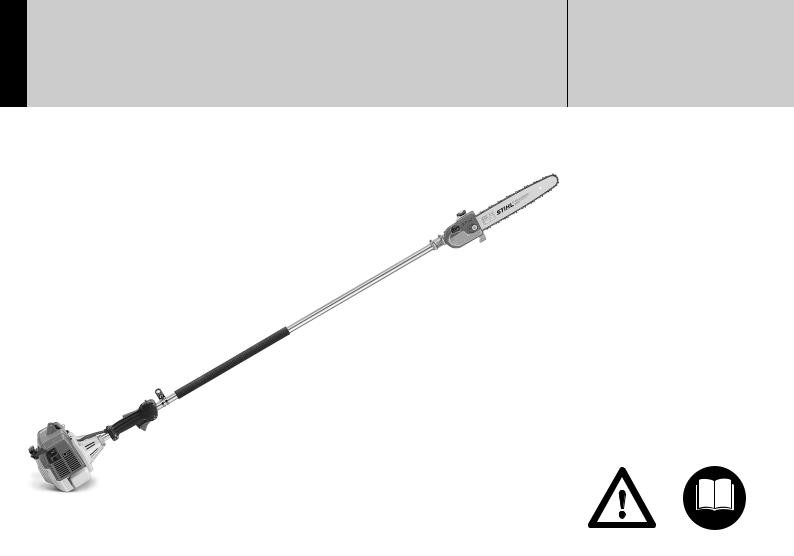
{
STIHL HT 250
Instruction Manual Manual de instrucciones
Warning!
Read and follow all safety precautions in Instruction Manual – improper use can cause serious or fatal injury.
Advertencia!
Lea y siga todas las precauciones de seguridad dadas en el manual de instrucciones – el uso incorrecto puede causar lesiones graves o mortales.
Instruction Manual 1 - 44
Manual de instrucciones 45 - 92
Contents
|
|
Guide to Using this Manual |
2 |
|
|
|
Safety Precautions and Working |
|
|
|
|
Techniques |
2 |
|
Manual |
|
Using the Unit |
14 |
|
|
Mounting the Bar and Chain |
16 |
||
Instruction |
|
Checking Chain Tension |
17 |
|
|
|
Tensioning the Chain |
17 |
|
Original |
|
Adjusting the Throttle Cable |
17 |
|
|
Fuel |
18 |
||
|
recycled. |
Fueling |
19 |
|
|
Filling Chain Oil Tank |
20 |
||
|
|
Chain Lubricant |
19 |
|
|
be |
Checking Chain Lubrication |
21 |
|
|
can |
|||
|
Fitting the Harness |
21 |
||
|
paper |
|||
|
Starting / Stopping the Engine |
21 |
||
|
oils, |
|||
|
Operating Instructions |
23 |
||
paperfree-chlorineon vegetablecontaininks |
||||
Taking Care of the Guide Bar |
24 |
|||
|
|
|||
|
|
Replacing the Air Filter |
25 |
|
|
|
Engine Management |
25 |
|
|
|
Adjusting the Carburetor |
25 |
|
Printed |
Printing |
Spark Plug |
27 |
|
Engine Running Behavior |
28 |
|||
|
|
Replacing the Starter Rope and |
|
|
|
|
Rewind Spring |
28 |
|
|
|
Storing the Machine |
30 |
|
2011 |
|
Checking and Replacing the Chain |
|
|
A.-8621-275-0458M0-55.E11.PM. 0040000000847GB |
Sprocket |
30 |
||
STIHLANDREAS© AG & Co. KG, |
{ |
|
||
|
|
Maintaining and Sharpening the |
|
|
|
|
Saw Chain |
31 |
|
|
|
Inspections and Maintenance by |
|
|
|
|
Dealer |
35 |
|
|
|
Maintenance and Care |
36 |
|
Main Parts
Specifications
Special Accessories
Maintenance and Repairs
STIHL Incorporated Federal
Emission Control Warranty
Statement
Trademarks
English
38 |
Allow only persons who fully understand |
|
this manual to operate your pole pruner. |
||
40 |
||
To receive maximum performance and |
||
41 |
41 |
satisfaction from your STIHL pole |
|
pruner, it is important that you read, |
||
|
||
|
understand and follow the safety |
|
41 |
precautions and the operating and |
|
maintenance instructions in chapter |
43"Safety Precautions and Working Techniques" before using your pole pruner. For further information you can go to www.stihlusa.com.
Contact your STIHL dealer or the STIHL distributor for your area if you do not understand any of the instructions in this manual.
 Warning!
Warning!
Because a pole pruner is a high-speed, fast-cutting power tool with a very long reach, special safety precautions must be observed to reduce the risk of personal injury. Careless or improper use may cause serious or even fatal injury.
HT 250 |
1 |

English
Guide to Using this Manual
Pictograms
All the pictograms attached to or embossed on the machine are shown and explained in this manual.
Symbols in Text
Many operating and safety instructions are supported by illustrations.
The individual steps or procedures described in the manual may be marked in different ways:
N A bullet marks a step or procedure.
A description of a step or procedure that refers directly to an illustration may contain item numbers that appear in the illustration. Example:
N Loosen the screw (1). N Lever (2) ...
In addition to the operating instructions, this manual may contain paragraphs that require your special attention. Such paragraphs are marked with the symbols and signal words described below:
Danger!
Indicates an imminent risk of severe or fatal injury.
2
Warning!
Indicates a hazardous situation which, if not avoided, could result in severe or fatal injury.
Caution!
Indicates a risk of property damage, including damage to the machine or its individual components.
Engineering Improvements
STIHL’s philosophy is to continually improve all of its products. As a result, engineering changes and improvements are made from time to time. Therefore, some changes, modifications and improvements may not be covered in this manual. If the operating characteristics or the appearance of your machine differ from those described in this manual, please contact your STIHL dealer for assistance.
Safety Precautions and
Working Techniques
Because a pole pruner is a high-speed, fast-cut- ting power tool with a
very long reach, special safety precautions must be observed to reduce the risk of personal injury.
It is important that you read, fully understand and observe the following safety precautions and warnings. Read the instruction manual and the safety precautions periodically. Careless or improper use may cause serious or fatal injury.
Have your STIHL dealer show you how to operate your power tool. Observe all applicable local safety regulations, standards and ordinances.
Warning!
Do not lend or rent your power tool without the instruction manual. Be sure that anyone using it understands the information contained in this manual.
Warning!
The use of this machine may be hazardous. The pole pruner chain has many sharp cutters. If the cutters contact your flesh, they will cut you, even if the chain is not moving.
Do not cut any material other than wood or wooden objects. Use your pole pruner for limbing only.
HT 250
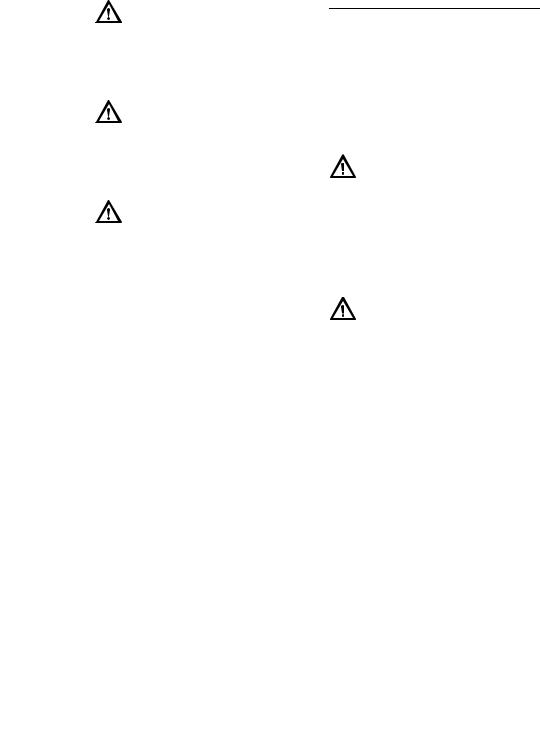
Warning!
Do not use it for other purposes, since misuse may result in personal injury or property damage, including damage to the machine.
Warning!
Minors should never be allowed to use this power tool. Bystanders, especially children, and animals should not be allowed in the area where it is in use.
Warning!
To reduce the risk of injury to bystanders and damage to property, never let your power tool run unattended. When it is not in use (e. g. during a work break), shut it off and make sure that unauthorized persons do not use it.
Most of these safety precautions and warnings apply to the use of all STIHL pole pruners. Different models may have different parts and controls. See the appropriate section of your instruction manual for a description of the controls and the function of the parts of your model.
Safe use of a pole pruner involves
1.the operator
2.the power tool
3.the use of the power tool.
THE OPERATOR
Physical Condition
You must be in good physical condition and mental health and not under the influence of any substance (drugs, alcohol, etc.) which might impair vision, dexterity or judgment. Do not operate this machine when you are fatigued.
Warning!
Be alert – if you get tired, take a break. Tiredness may result in loss of control. Working with any power tool can be strenuous. If you have any condition that might be aggravated by strenuous work, check with your doctor before operating this machine.
Warning!
Prolonged use of a power tool (or other machines) exposing the operator to vibrations may produce whitefinger disease (Raynaud's phenomenon) or carpal tunnel syndrome.
These conditions reduce the hand's ability to feel and regulate temperature, produce numbness and burning sensations and may cause nerve and circulation damage and tissue necrosis.
All factors which contribute to whitefinger disease are not known, but cold weather, smoking and diseases or physical conditions that affect blood vessels and blood transport, as well as high vibration levels and long periods of exposure to vibration are mentioned as factors in the development of whitefinger
English
disease. In order to reduce the risk of whitefinger disease and carpal tunnel syndrome, please note the following:
–Most STIHL power tools are available with an anti-vibration ("AV") system designed to reduce the transmission of vibrations created by the machine to the operator's hands. An AV system is recommended for those persons using power tools on a regular or sustained basis.
–Wear gloves and keep your hands warm.
–Keep the AV system well maintained. A power tool with loose components or with damaged or worn AV elements will tend to have higher vibration levels.
–Maintain a firm grip at all times, but do not squeeze the handles with constant, excessive pressure. Take frequent breaks.
All the above-mentioned precautions do not guarantee that you will not sustain whitefinger disease or carpal tunnel syndrome. Therefore, continual and regular users should closely monitor the condition of their hands and fingers. If any of the above symptoms appear, seek medical advice immediately.
HT 250 |
3 |
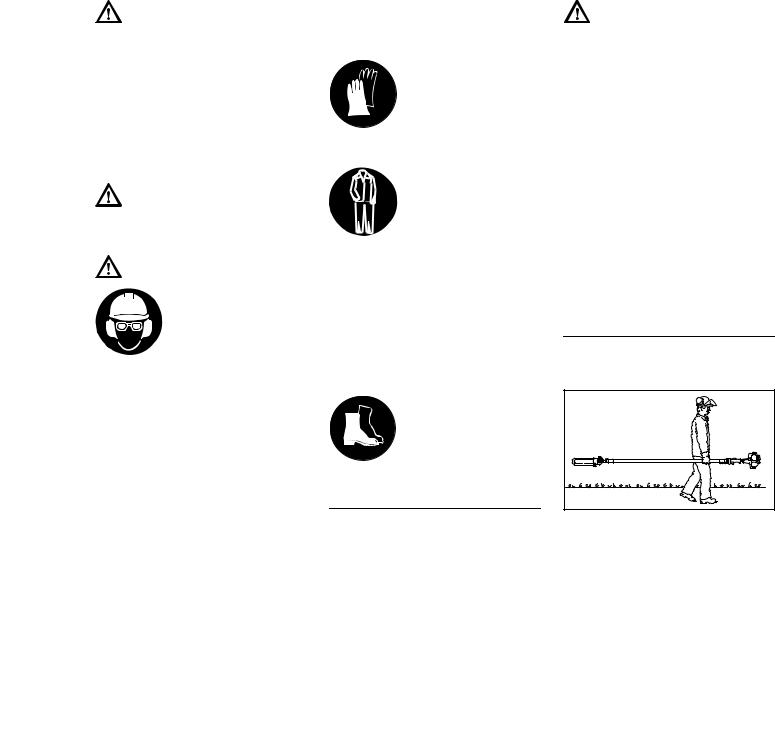
English
Warning!
The ignition system of the STIHL unit produces an electromagnetic field of a very low intensity. This field may interfere with some pacemakers. To reduce the risk of serious or fatal injury, persons with a pacemaker should consult their physician and the pacemaker manufacturer before operating this tool.
Proper Clothing
Warning!
To reduce the risk of injury, the operator should wear proper protective apparel.
Warning!
To reduce the risk of injury to your eyes never operate your power tool
unless wearing goggles
or properly fitted protective glasses with
adequate top and side protection complying with ANSI Z 87.1 (or your applicable national standard). To reduce the risk of injury to your face STIHL recommends that you also wear a face shield or face screen over your goggles or protective glasses.
Wear an approved safety hard hat to reduce the risk of injury to your head.
Power tool noise may damage your hearing. Wear sound barriers (ear plugs or ear mufflers) to protect your hearing. Continual and regular users should have their hearing checked regularly.
Be particularly alert and cautious when wearing hearing protection because your ability to hear warnings (shouts, alarms, etc.) is restricted.
Always wear gloves when handling the machine and the cutting tool. Heavy-duty, nonslip gloves improve your grip and help to protect your hands.
Clothing must be sturdy and snug-fitting, but allow
complete freedom of movement. Wear long pants made of heavy material to help protect your legs. Do not wear shorts, sandals or go barefoot.
Avoid loose-fitting jackets, scarfs, neckties, jewelry, flared or cuffed pants, unconfined long hair or anything that could become caught on branches, brush or the moving parts of the unit. Secure hair so it is above shoulder level.
Good footing is very important. Wear sturdy boots with nonslip soles. Steel-toed safety boots with cut retardant inserts are recommended.
THE POWER TOOL
For illustrations and definitions of the power tool parts see the chapter on "Main Parts".
Warning!
Never modify this power tool in any way. Only attachments supplied by STIHL or expressly approved by STIHL for use with the specific STIHL model are authorized. Although certain unauthorized attachments are useable with STIHL power tools, their use may, in fact, be extremely dangerous.
If this tool is subjected to unusually high loads for which it was not designed (e. g. heavy impact or a fall), always check that it is in good condition before continuing work. Check in particular that the fuel system is tight (no leaks) and that the controls and safety devices are working properly. Do not continue operating this machine if it is damaged. In case of doubt, have it checked by your STIHL servicing dealer.
THE USE OF THE POWER TOOL
Transporting the Power Tool
390BA000 KN |
This power tool should be carried only in a horizontal position. Grip the shaft in a manner that the machine is balanced horizontally. Keep the hot muffler away from your body and the cutting attachment behind you. Accidental
4 |
HT 250 |
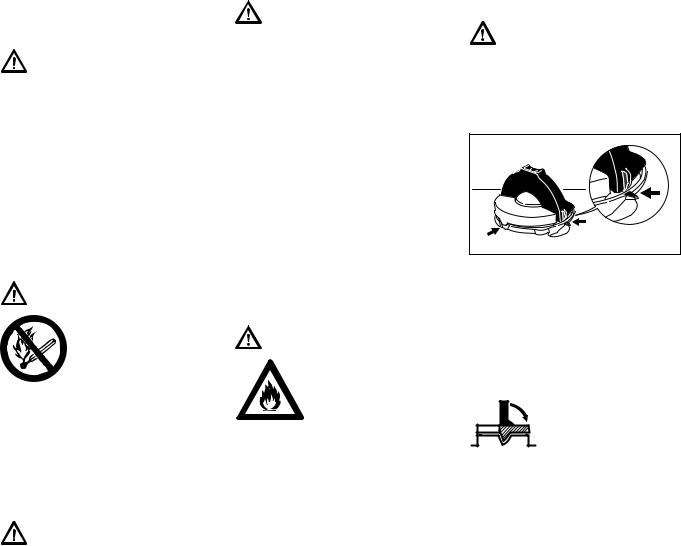
acceleration of the engine can cause the chain to rotate and cause serious injuries.
Warning!
Always switch off the engine and fit the scabbard over the cutting attachment before transporting the power tool over long distances. When transporting it in a vehicle, properly secure it to prevent turnover, fuel spillage and damage to the unit.
Fuel
Your STIHL power tool uses an oilgasoline mixture for fuel (see the chapter on "Fuel" of your instruction manual).
Warning!
Gasoline is an extremely flammable fuel. If spilled and ignited by a spark or
other ignition source, it can cause fire and serious burn injury or
property damage. Use extreme caution when handling gasoline or fuel mix. Do not smoke or bring any fire or flame near the fuel or the power tool. Note that combustible fuel vapor may escape from the fuel system.
Fueling Instructions
Warning!
To reduce the risk of serious injury from burns, never attempt to refuel the unit until it has been completely removed from the operator.
Warning!
Fuel your power tool in well-ventilated areas, outdoors. Always shut off the engine and allow it to cool before refueling. Gasoline vapor pressure may build up inside the fuel tank depending on the fuel used, the weather conditions and the tank venting system.
In order to reduce the risk of burns and other personal injury from escaping gas vapor and fumes, remove the fuel filler cap on your power tool carefully so as to allow any pressure build-up in the tank to release slowly. Never remove the fuel filler cap while the engine is running.
Select bare ground for fueling and move at least 10 feet (3 m) from the fueling spot before starting the engine. Wipe off any spilled fuel before starting your machine.
Warning!
Check for fuel leakage while refueling and dur-
ing operation. If fuel leakage is found, do not start or run the engine until the leak is fixed and
any spilled fuel has been wiped away. Take care not to get fuel on your clothing. If this happens, change your clothing immediately.
Different models may be equipped with different fuel caps.
English
Toolless cap with grip
Warning!
In order to reduce the risk of fuel spillage and fire from an improperly tightened fuel cap, correctly position and tighten the fuel cap in the fuel tank opening.
001BA220 KN
To do this with this STIHL cap, raise the grip on the top of the cap until it is upright at a 90° angle. Insert the cap in the fuel tank opening with the raised positioning marks on the grip of the cap and on the fuel tank opening lining up. Using the grip, press the cap down firmly while turning it clockwise as far as it will go (approx. 1/4 turn).
Fold the grip flush with the top of the cap. Grip
the cap and check for tightness. If the grip does not lie completely flush with the cap and the detent on the grip does not fit in the corresponding recess in the filler opening, or if the cap is loose in the filler opening, the cap is not properly seated and tightened and you must repeat the above steps.
HT 250 |
5 |
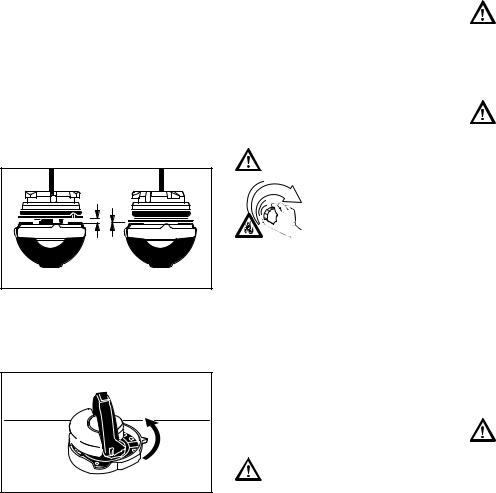
English
Misaligned, damaged or broken cap
NIf the cap does not drop fully into the opening when the positioning marks line up and/or if the cap does not tighten properly when twisted, the base of the cap may be prematurely rotated (in relation to the top) to the closed position. Such misalignment can result from handling, cleaning or an improper attempt at tightening.
001BA227 KN |
Left: |
Base of cap in closed posi- |
|
tion (with open space) |
Right: |
Base of cap correctly posi- |
|
tioned for installation |
001BA226 KN |
NTo return the cap to the open position for installation, turn the cap (with the grip up) until it drops fully into the tank opening. Next, twist the cap counterclockwise as far as it will go (approx. 1/4 turn) – this will twist
the base of the cap into the correct position. Then, twist the cap clockwise, closing it normally.
NIf your cap still does not tighten properly, it may be damaged or broken; immediately stop use of the unit and take it to your authorized STIHL dealer for repair.
Screw Cap
Warning!
Unit vibrations can cause an improperly tightened
fuel filler cap to loosen or
come off and spill quanti-
 ties of fuel. In order to reduce the risk of fuel spillage and fire, tighten the fuel filler
ties of fuel. In order to reduce the risk of fuel spillage and fire, tighten the fuel filler
cap by hand as securely as possible.
See also the "Fueling" chapter in your Instruction Manual for additional information.
Before Starting
Take off the chain guard (scabbard) and inspect the pole pruner for proper condition and operation. (See the maintenance chart near the end of the instruction manual.)
Warning!
Always check your power tool for proper condition and operation before starting, particularly the throttle trigger, throttle trigger lockout, stop switch and cutting attachment. The throttle trigger must move freely and always spring back to the idle position. Never attempt to modify the controls or safety devices.
Warning!
Never operate your power tool if it is damaged, improperly adjusted or maintained, or not completely or securely assembled.
Warning!
Check that the spark plug boot is securely mounted on the spark plug – a loose boot may cause arcing that could ignite combustible fumes and cause a fire.
Keep the handles clean and dry at all times; it is particularly important to keep them free of moisture, pitch, oil, fuel mix, grease or resin in order for you to maintain a firm grip and properly control your power tool.
For proper assembly of the bar and chain follow the procedure described in the chapter "Mounting the Bar and Chain" of your instruction manual.
STIHL Oilomatic chain, guide bar and sprocket must match each other in gauge and pitch.
Warning!
Proper chain tension is extremely important. In order to avoid improper setting, the tensioning procedure must be followed as described in your manual. Always make sure the hex nut(s) for the sprocket cover is (are) tightened securely after tensioning the chain. Check chain tension once more after having tightened the nut(s). Never start the pole pruner with the sprocket cover loose.
6 |
HT 250 |
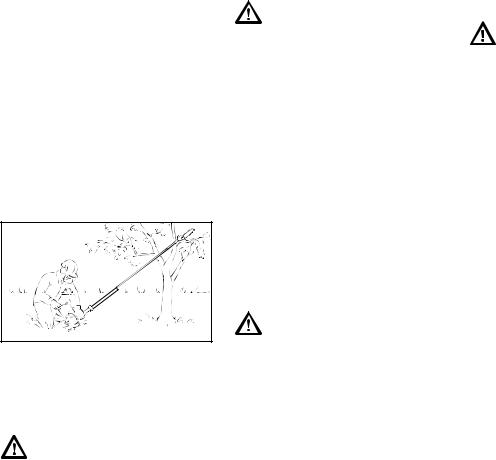
Adjust carrying harness and hand grip to suit your size before starting work.
Starting
To reduce the risk of fire and burn injuries, start the engine at least 10 feet (3 m) from the fueling spot, outdoors only.
Start and operate your pole pruner without assistance.
For specific starting instructions, see the appropriate section of your manual. Proper starting methods reduce the risk of injury.
275BA006 KN
Place the pole pruner on firm ground or other solid surface in an open area or, in the alternative, as shown in the above picture. Maintain good balance and secure footing.
Warning!
To reduce the risk of injury from loss of control, do not attempt to "drop start" your power tool.
Warning!
To reduce the risk of injury from loss of control be absolutely sure that the guide bar and chain are clear of you and all other obstructions and objects, including the ground, because when the engine starts at starting-throttle, engine speed will be fast enough for the clutch to engage the sprocket and turn the chain.
Once the engine has started, immediately blip the throttle trigger, which should release the starting throttle and allow the engine to slow down to idle.
With the engine running only at idle, attach the power tool to the spring hook of your harness (see appropriate chapter of this manual).
Warning!
When you pull the starter grip, do not wrap the starter rope around your hand. Do not let the grip snap back, but guide the starter rope to rewind it properly. Failure to follow this procedure may result in injury to your hand or fingers and may damage the starter mechanism.
English
Important Adjustments
Warning!
To reduce the risk of personal injury from loss of control or contact with the running cutting tool, do not use your unit with incorrect idle adjustment. At correct idle speed, the saw chain should not move. For directions on how to adjust idle speed, see the appropriate section of your instruction manual.
If you cannot set the correct idle speed, have your STIHL dealer check your power tool and make proper adjustments and repairs.
Proper chain tension is very important at all times. Check it at regular intervals (whenever the pole pruner is shut off). If the chain becomes loose while cutting, switch off the engine and then tighten. Never try to tighten the chain while the engine is running.
During Operation
Holding and Controlling the Power Tool
Always hold the unit firmly with both hands on the handles while you are working. Wrap your fingers and thumbs around the handles.
HT 250 |
7 |
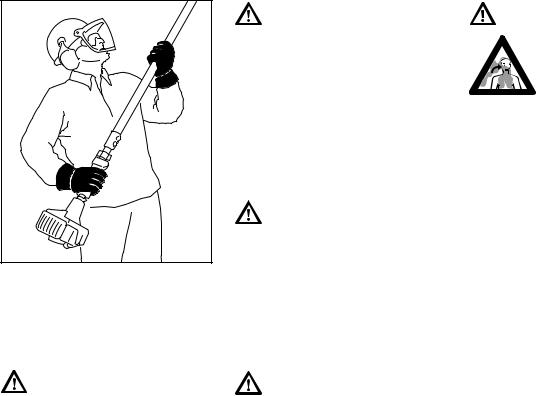
English |
390BA026 KN |
Place your left hand on the shaft and your right hand on rear grip and throttle trigger. Left-handers should follow these instructions, too. Keep your hands in this position to have your pole pruner under control at all times.
Warning!
Never attempt to operate your power tool with one hand. Loss of control of the power tool resulting in serious or fatal injury may result.
Warning!
In order to properly control your pole pruner, always maintain good balance and a firm foothold. Never work on a ladder, in a tree or on any other insecure support. Never hold the machine above shoulder height. Do not overreach. When working at a height above 15 feet (4.5 m) use a lift bucket. For pole pruner with adjustable shaft, expand the shaft only as far as necessary for the intended application.
Warning!
Special care must be taken in slippery conditions (wet ground, snow) and in difficult, overgrown terrain. Watch for hidden obstacles such as tree stumps, roots, rocks, holes and ditches to avoid stumbling. For better footing, clear away fallen branches, scrub and cuttings. Be extremely cautious when working on slopes or uneven ground.
Warning!
Take extreme care in wet and freezing weather (rain, snow, ice). Put off the work when the weather is windy, stormy or rainfall is heavy.
Working Conditions
Operate and start your power tool only outdoors in a well-ventilated area. Operate it under good visibility and daylight conditions only. Work carefully.
Warning!
As soon as the engine is running, this product generates toxic exhaust fumes containing chemicals, such as unburned hydrocarbons (including
benzene) and carbon monoxide, that are known to cause respiratory problems, cancer, birth defects, or other reproductive harm. Some of the gases (e. g. carbon monoxide) may be colorless and odorless. To reduce the risk of serious or fatal injury / illness from inhaling toxic fumes, never run the machine indoors or in poorly ventilated locations. If exhaust fumes become concentrated due to insufficient ventilation, clear obstructions from work area to permit proper ventilation before proceeding and / or take frequent breaks to allow fumes to dissipate before they become concentrated.
8 |
HT 250 |
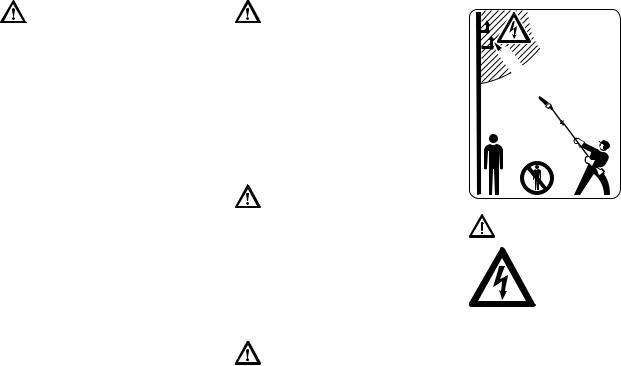
Warning!
Inhalation of certain dusts, especially organic dusts such as mold or pollen, can cause susceptible persons to have an allergic or asthmatic reaction. Substantial or repeated inhalation of dust and other airborne contaminants, in particular those with a smaller particle size, may cause respiratory or other illnesses. This includes wood dust, especially from hardwoods, but also from some softwoods such as Western Red Cedar. Control dust at the source where possible. Use good work practices, such as such as always cutting with a properly sharpened chain (which produces wood chips rather than fine dust) and operating the unit so that the wind or operating process directs any dust raised by the power tool away from the operator. Follow the recommendations of EPA / OSHA / NIOSH and occupational and trade associations with respect to dust ("particulate matter"). When the inhalation of dust cannot be substantially controlled, i.e., kept at or near the ambient (background) level, the operator and any bystanders should wear a respirator approved by NIOSH / MSHA for the type of dust encountered.
Warning!
Breathing asbestos dust is dangerous and can cause severe or fatal injury, respiratory illness or cancer. The use and disposal of asbestos-containing products have been strictly regulated by OSHA and the Environmental Protection Agency. If you have any reason to believe that you might be cutting asbestos, immediately contact your employer or a local OSHA representative.
Warning!
This power tool has a large range. In order to reduce the risk of personal or even fatal injury to bystanders from falling objects or inadvertent contact with the moving chain of your power tool always keep bystanders at least 50 feet (15 m) away when the power tool is running.
Warning!
Even though bystanders should be kept away from the running saw, never work alone. Keep within calling distance of others in case help is needed.
Stop the engine immediately if you are approached.
English
15m
(50ft)
 15m
15m
Danger!
Your power tool is not insulated against electric shock. To reduce the risk of electrocution, never operate this power tool in the vicinity of any wires or
cables (power, etc.) which may be carrying electric current.
Electricity can jump from one point to another by means of arcing. Higher voltage increases the distance electricity can arc. Electricity can also move through branches, especially if they are wet. Maintain a clearance of at least 50 feet (15 m) between the pole pruner (including any branches it is contacting) and any electrical line carrying live current. Before working with less clearance, contact your electric utility and make sure the current is turned off.
HT 250 |
9 |
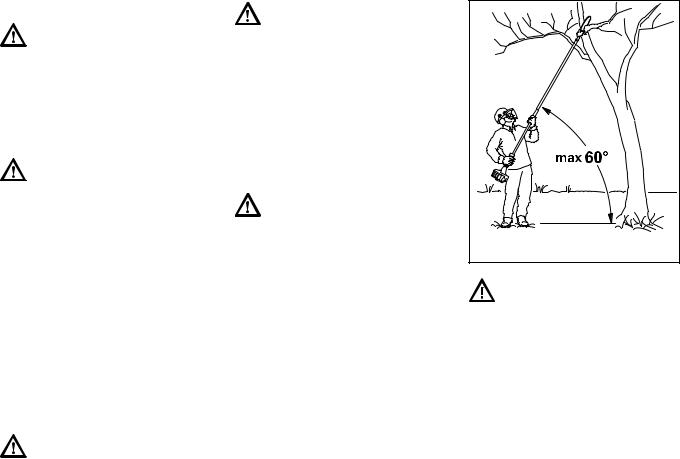
English
Operating Instructions
Warning!
Do not operate your power tool using the starting throttle position, as you do not have control of the engine speed.
In the event of an emergency, switch off the engine immediately – move the slide control / stop switch to 0 or STOP.
Warning!
To reduce the risk of cut injuries, keep hands and feet away from the saw chain. Never touch a moving chain with your hand or any other part of your body. The saw chain continues to move for a short period after the throttle trigger is released (inertia effect).
Accelerating the engine while the chain is blocked increases the load and will cause the clutch to slip continuously. This may result in overheating and damage to important components (e. g. clutch, polymer housing components) – which can then increase the risk of injury from the chain moving while the engine is idling.
Warning!
If the chain becomes clogged, always turn off the engine and make sure the chain has stopped before cleaning.
Make sure that the saw chain does not touch any foreign materials such as rocks, fences, nails and the like. Such objects may be flung off and injure the operator or bystanders, or damage the saw chain.
Warning!
Prior to limbing, clear the working area from interfering limbs and brush. Then, establish an escape area away from where the cut limbs can fall, and remove all obstacles.
Keep work area clear – move away fallen limbs. Place all tools and equipment at a safe distance from the branches being limbed, but not in the escape area.
Warning!
Always observe the general condition of the tree. Look for decay and rot in the trunk and branches. If it is rotted inside, it could snap and fall toward the operator while being cut. Also look for broken or dead branches which could vibrate loose and fall on the operator. If branch is thick or heavy, make a shallow relief cut on the bottom of the branch before cutting down from the top to help prevent splitting of the branch.
275BA005 KN |
Warning! |
To reduce the risk of severe or even fatal injury from falling objects do not cut vertically above your body. Hold the pole pruner at an angle of not more than 60° from the horizontal level (see picture). Objects may fall in unexpected directions. Do not stand directly underneath the limb being cut!
Watch for falling wood! As soon as the limbed branch starts to fall, step aside and keep a sufficient distance away from the falling wood.
10 |
HT 250 |
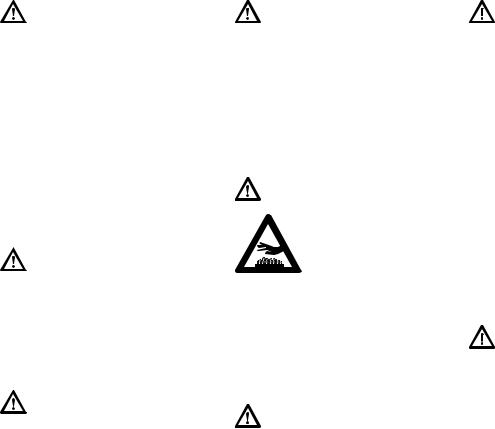
Warning!
Always pull the unit out of the cut with the chain running to reduce the possibility of pinching the cutting attachment. Don't put pressure on the pole pruner when reaching the end of a cut. The pressure may cause the bar and rotating chain to pop out of the cut or kerf, go out of control and strike some other object.
If the bar becomes pinched and caught in the branch so that the chain can no longer move, shut off the pole pruner and carefully move the branch to open the pinch and release the bar.
Warning!
The muffler and other parts of the engine (e. g. fins of the cylinder, spark plug) become hot during operation and remain hot for a while after stopping the engine. To reduce risk of burns do not touch the muffler and other parts while they are hot.
Warning!
To reduce the risk of fire and burn injury, keep the area around the muffler clean. Remove excess lubricant and all debris such as pine needles, branches or leaves. Let the engine cool down sitting on concrete, metal, bare ground or solid wood (e. g. the trunk of a felled tree) away from any combustible substances.
Warning!
Never modify your muffler. The muffler could be damaged and cause an increase in heat radiation or sparks, thereby increasing the risk of fire and burn injury. You may also permanently damage the engine. Have your muffler serviced and repaired by your STIHL servicing dealer only.
Catalytic Converter
Warning!
Some STIHL power tools are equipped with a catalytic converter, which is designed to reduce the exhaust emissions of the engine by a chemical
process in the muffler. Due to this process, the muffler does not cool down as rapidly as conventional mufflers when the engine returns to idle or is shut off. To reduce the risk of fire and burn injuries, the following specific safety precautions must be observed.
Warning!
Since a muffler with a catalytic converter cools down less rapidly than conventional mufflers, always set your power tool down in the upright position and never locate it where the muffler is near dry brush, grass, wood chips or other combustible materials while it is still hot.
English
Warning!
An improperly mounted or damaged cylinder housing or a damaged / deformed muffler shell may interfere with the cooling process of the catalytic converter.
To reduce the risk of fire or burn injury, do not continue work with a damaged or improperly mounted cylinder housing or a damaged / deformed muffler shell.
Your catalytic converter is furnished with screens designed to reduce the risk of fire from the emission of hot particles. Due to the heat from the catalytic reaction, these screens will normally stay clean and need no service or maintenance. If you experience loss of performance and you suspect a clogged screen, have your muffler maintained by a STIHL servicing dealer.
Reactive Forces
Warning!
Reactive forces may occur any time the chain is rotating.The force used to cut wood can be reversed and work against the operator. If the rotating chain is suddenly stopped by contact with any solid object such as a branch or is pinched, the reactive forces may occur instantly. These reactive forces may result in loss of control, which, in turn, may cause personal injury. An understanding of the causes of these reactive forces may help you avoid the element of surprise and loss of control.
Because of the design of the pole pruner, the reactive forces experienced when working with it are generally not as severe as those encountered with a chainsaw. Nevertheless, you should
HT 250 |
11 |
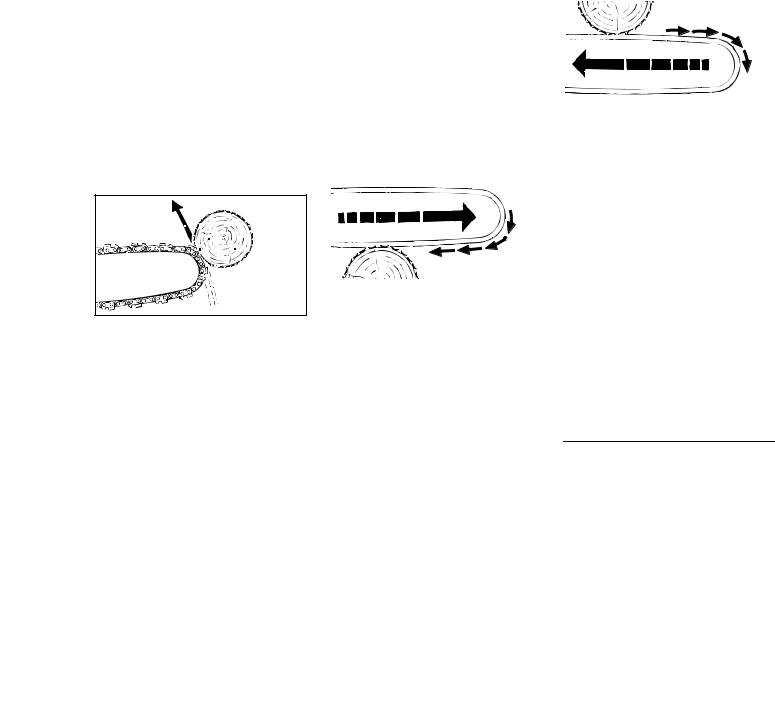
English
always maintain a proper grip and good footing to control the power tool when you experience such forces.
The most common reactive forces are:
–kickback,
–pushback,
–pull-in.
Kickback
Kickback may occur when the moving saw chain near the upper quadrant of the bar nose contacts a solid object or is pinched.
002BA230 KN
The reaction of the cutting force of the chain causes a rotational force on the chainsaw in the direction opposite to the chain movement. This may cause the bar to move upward.
To Avoid Kickback
The best protection from kickback is to avoid kickback situations:
1.Be aware of the location of the guide bar nose at all times.
2.Never let the nose of the guide bar contact any object. Do not cut limbs with the nose of the guide bar. Be especially careful near wire fences and when cutting small, tough limbs, which may easily catch the chain.
3.Cut only one limb at a time.
A = Pull-in
A |
001BA037 KN |
|
|
Pull-in occurs when the chain on the bottom of the bar is suddenly stopped when it is pinched, caught or encounters a foreign object in the wood. The reaction of the chain pulls the saw forward.
Pull-in frequently occurs when the chain is not rotating at full speed before it contacts the wood.
To Avoid Pull-in
1.Be alert to forces or situations that may cause material to pinch the chain at the bottom of the bar.
2.Always start a cut with the chain rotating at full speed.
B = Pushback
B |
001BA038 KN |
|
|
Pushback occurs when the chain on the top of the bar is suddenly stopped when it is pinched, caught or encounters a foreign object in the wood. The reaction of the chain may drive the saw rapidly straight back toward the operator. Pushback frequently occurs when the top of the bar is used for cutting.
To Avoid Pushback
1.Be alert to forces or situations that may cause material to pinch the chain at the top of the bar.
2.Do not cut more than one limb at a time.
3.Do not twist the bar when withdrawing it from an underbuck cut because the chain can pinch.
MAINTENANCE, REPAIR AND STORING
Maintenance, replacement, or repair of the emission control devices and systems may be performed by any nonroad engine repair establishment or individual. However, if you make a warranty claim for a component which has not been serviced or
12 |
HT 250 |

maintained properly or if nonapproved replacement parts were used, STIHL may deny coverage.
Warning!
Use only identical STIHL replacement parts for maintenance and repair. Use of non-STIHL parts may cause serious or fatal injury.
Strictly follow the maintenance and repair instructions in the appropriate sections of your instruction manual.
Please refer to the maintenance chart in this manual.
Warning!
Always stop the engine and make sure that the chain is stopped before doing any maintenance or repair work or cleaning the power tool. Do not attempt any maintenance or repair work not described in your instruction manual. Have such work performed by your STIHL servicing dealer only.
Wear gloves when handling or performing maintenance on the cutting attachment.
Warning!
Use the specified spark plug and make sure it and the ignition lead are always clean and in good condition. Always press spark plug boot snugly onto spark plug terminal of the proper size. (Note: If terminal has detachable SAE adapter nut, it must be securely attached.) A loose connection between spark plug terminal and the ignition wire connector in the boot may create arcing that could ignite combustible fumes and cause a fire.
Warning!
Never test the ignition system with the ignition wire boot removed from the spark plug or with a removed spark plug, since uncontained sparking may cause a fire.
Warning!
Do not operate your power tool if the muffler is damaged, missing or modified. An improperly maintained muffler will increase the risk of fire and hearing loss. If your muffler was equipped with a spark-arresting screen to reduce the risk of fire, never operate your power tool if the screen is missing or damaged. Remember that the risk of forest fires is greater in hot or dry weather.
English
Warning!
Keep the chain, bar and sprocket clean; replace worn sprockets or chains. Keep the chain sharp. You can spot a dull chain when easy-to-cut wood becomes hard to cut or burn marks appear on the wood. Keep chain at proper tension.
Tighten all nuts, bolts and screws except the carburetor adjustment screws after each use.
For maintenance items please also refer to the maintenance chart in this manual.
Do not clean your machine with a pressure washer. The solid jet of water may damage parts of the machine.
Store the power tool in a dry and high or locked location out of reach of children.
Before storing for longer than a few days, always empty the fuel tank. See chapter "Storing the machine" in this manual.
Store fuel and chain oil in approved and properly labeled safety-type canisters only. Take care when handling gasoline! Avoid direct contact with the skin and avoid inhaling fuel vapor!
HT 250 |
13 |
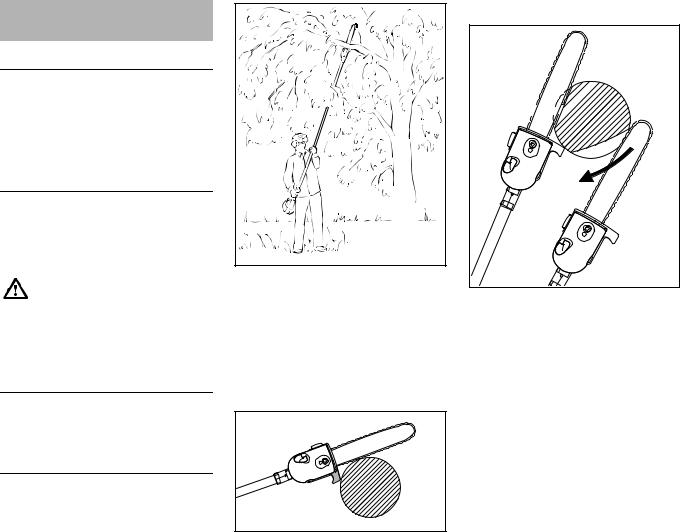
English
Using the Unit
Preparations
NWear suitable protective clothing, observe safety precautions.
N Starting the engine
N Put on the shoulder strap.
Cutting Sequence
To allow branches a free fall, always cut the lower branches first. Prune heavy branches (large diameter) in several controllable pieces.
Never stand directly underneath the branch you are cutting – be wary of falling branches. Note that a branch may spring back at you after it hits the ground – risk of injury.
Disposal
Do not throw cuttings into the garbage can – they can be composted.
Working Techniques
Hold the control handle with your right hand, and the shaft with your left hand. Your left arm should be extended to the most comfortable position.
Always hold the shaft with your left hand in the area of the handle hose.



 275BA002 KN
275BA002 KN
The shaft should always be held at an angle of 60° or less.
The least tiring working position is a tool angle of 60°.
Any lesser angle may be used to suit the situation concerned.
Cross-cut
390BA052 KN
To avoid pinching the bar in the cut, position the cutting attachment with the hook against the branch and then perform the cross-cut from the top downwards.
Relieving cut
 2
2
390BA041 KN
To avoid tearing the bark on thick branches, always start by performing a relieving cut (1) on the underside of the branch.
NTo do this, apply the cutting attachment and pull it across the bottom of the branch in an arc as far as the bar nose.
NThen position the bar with the hook against the branch and perform the cross-cut (2).
14 |
HT 250 |
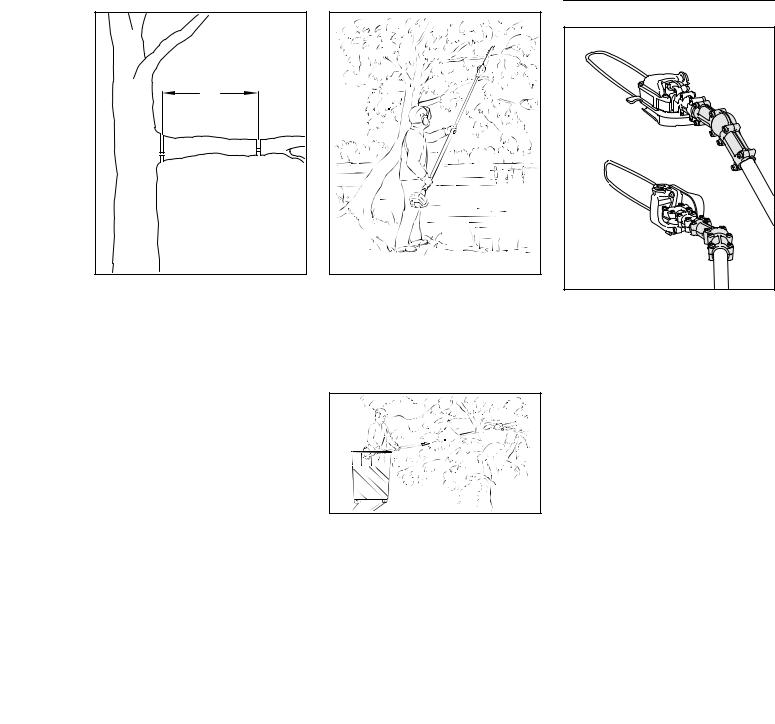
Flush-cutting thick branches
A
4 3
390BA024 KN
If branch diameter is more than 4 in (10 cm), first
Nperform an initial cut (3), with relieving cut and cross-cut at distance (A) of about 8 in (20 cm) from the final cut, then carry out the flush-cut (4), starting with a relieving cut and finishing with a cross-cut.
Cutting above obstacles
275BA003 KN |
The unit's long reach makes it possible to prune branches that are overhanging obstacles, such as rivers or lakes. The tool angle in this case depends on the position of the branch.
Cutting from a lift bucket


 275BA008 KN
275BA008 KN
The unit's long reach enables cutting to be performed next to the trunk without the risk of the lift bucket damaging other branches. The tool angle in this case depends on the position of the branch.
English
30° angle drive (special accessory)
1
2
390BA053 KN
The angle drive keeps the cutting attachment at an angle of 30° to the drive tube.
The angle drive may be adjusted on the drive tube to the following positions only:
1For cross-cutting vertical branches and bushes.
2For a better view of the cutting attachment.
HT 250 |
15 |
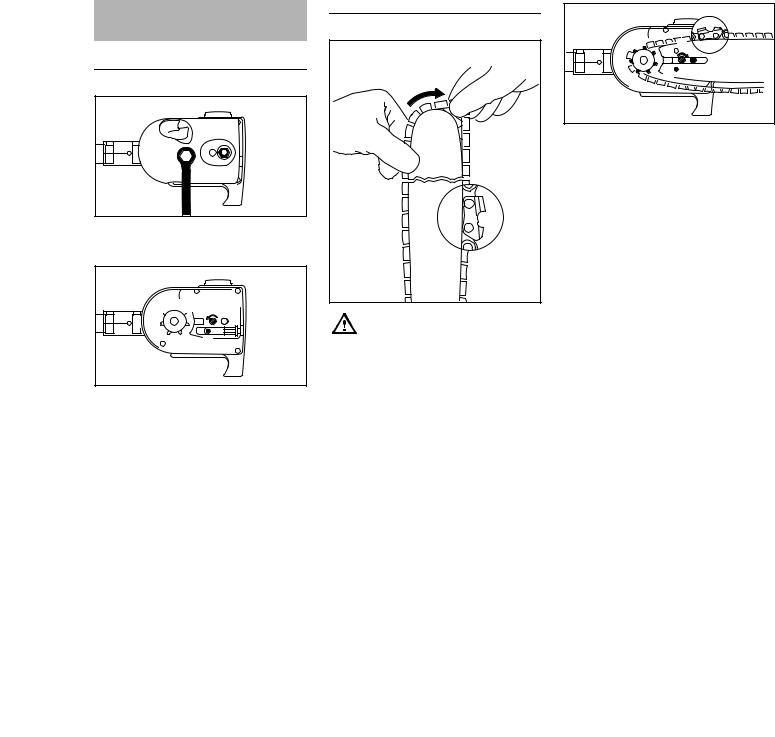
English
Mounting the Bar and
Chain
Removing the chain sprocket cover
390BA042 KN
NUnscrew the nut and remove the cover.





 1
1
2 |
KN |
|
390BA043 |
NTurn the screw (1) counterclockwise until the tensioner slide (2) butts against the left end of the housing slot, then back it off 5 full turns.
Fitting the chain
390BA003 KN |
Wear work gloves to protect your hands from the sharp cutters.
N Fit the chain – start at the bar nose.
5 |
1 |
|
|
4 |
3 |
|
390BA044KN |
NFit the guide bar over the screw (3) and engage peg of tensioner slide in the hole (4) – place the chain over the sprocket (5) at the same time.
NTurn the tensioning screw (1) clockwise until there is very little chain sag on the underside of the bar – and the drive link tangs are engaged in the bar groove.
NRefit the cover and screw on the nut fingertight.
NGo to chapter on "Tensioning the Saw Chain"
16 |
HT 250 |
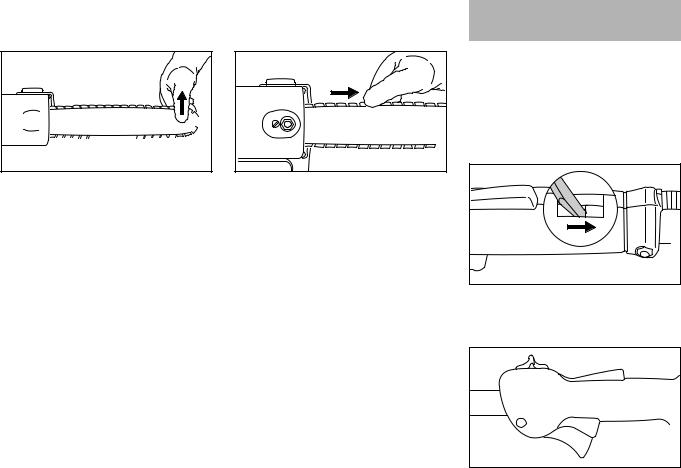
|
|
|
Tensioning the Chain |
Checking Chain Tension |
|
|
|
|
1




















 KN390BA045
KN390BA045
Retensioning during cutting work: N Stopping the engine
N Loosen the nut.
N Hold the bar nose up.
NUse a screwdriver to turn the tensioning screw (1) clockwise until the chain fits snugly against the underside of the bar.
NWhile still holding the bar nose up, tighten down the nut firmly.
N Go to "Checking Chain Tension".
A new chain has to be retensioned more often than one that has been in use for some time.
NCheck chain tension frequently – see chapter on "Operating Instructions".
390BA046 KN
N Shut off the engine
NWear work gloves to protect your hands.
NThe chain must fit snugly against the underside of the bar and it must still be possible to pull the chain along the bar by hand.
N If necessary, retension the chain.
A new chain has to be retensioned more often than one that has been in use for some time.
NCheck chain tension frequently – see chapter on "Operating Instructions".
English
Adjusting the Throttle
Cable
A properly adjusted throttle cable is the precondition for correct operation in the full throttle, starting throttle and idle positions.
NAdjust the throttle cable only when the unit is completely and properly assembled.
002BA163 KN
NUse a suitable tool to push the slide to the end of the slot (see illustration).
1
|
KN |
2 |
002BA161 |
|
NPress down the throttle trigger lockout (1) and squeeze the throttle trigger (2) (full throttle) – this sets the throttle cable correctly.
HT 250 |
17 |

English
Fuel
This engine is certified to operate on unleaded gasoline and the STIHL twostroke engine oil at a mix ratio of 50:1.
Your engine requires a mixture of highquality gasoline and two-stroke air cooled engine oil.
Use mid-grade unleaded gasoline with a minimum octane rating of 89 (R+M/2) and no more than 10% ethanol content.
Fuel with a lower octane rating may increase engine temperatures. This, in turn, increases the risk of piston seizure and damage to the engine.
The chemical composition of the fuel is also important. Some fuel additives not only detrimentally affect elastomers (carburetor diaphragms, oil seals, fuel lines, etc.), but magnesium castings and catalytic converters as well. This could cause running problems or even damage the engine. For this reason STIHL recommends that you use only high-quality unleaded gasoline!
Gasoline with an ethanol content of more than 10% can cause running problems and major damage in engines with a manually adjustable carburetor and should not be used in such engines.
The ethanol content in gasoline affects engine running speed – it may be necessary to readjust the carburetor if you use fuels with various ethanol contents.
Warning!
To reduce the risk of personal injury from loss of control and / or contact with the running cutting tool, do not use your unit with incorrect idle adjustment. At correct idle speed, the cutting tool should not move.
If your power tool shows an incorrect idle adjustment, have your STIHL dealer check your power tool and make proper adjustments and repairs.
The idle speed and maximum speed of the engine change if you switch from a fuel with a certain ethanol content to another fuel with a much higher or lower ethanol content.
This problem can be avoided by always using fuel with the same ethanol content.
Use only STIHL two-stroke engine oil or equivalent high-quality two-stroke engine oils that are designed for use only in air cooled two-cycle engines.
We recommend STIHL HP Ultra 2-Cycle Engine Oil since it is specially formulated for use in STIHL engines.
Do not use BIA or TCW rated (twostroke water cooled) mix oils or other mix oils that state they are for use in both water cooled and air cooled engines (e.g., outboard motors, snowmobiles, chain saws, mopeds, etc.).
Take care when handling gasoline. Avoid direct contact with the skin and avoid inhaling fuel vapor. When filling at the pump, first remove the container from your vehicle and place the container on the ground before filling. To reduce the risk of sparks from static
discharge and resulting fire and/or explosion, do not fill fuel containers that are sitting in or on a vehicle or trailer.
The container should be kept tightly closed in order to limit the amount of moisture that gets into the mixture.
The machine‘s fuel tank should be cleaned as necessary.
Fuel mix ages
Only mix sufficient fuel for a few days work, not to exceed 3 months of storage. Store in approved fuel-containers only. When mixing, pour oil into the container first, and then add gasoline. Close the container and shake it vigorously by hand to ensure proper mixing of the oil with the fuel.
Gaso- |
Oil (STIHL 50:1 or equiva- |
line |
lent high-quality oils) |
US gal. |
US fl.oz. |
1 |
2.6 |
2 1/2 |
6.4 |
5 |
12.8 |
Dispose of empty mixing-oil containers only at authorized disposal locations.
18 |
HT 250 |
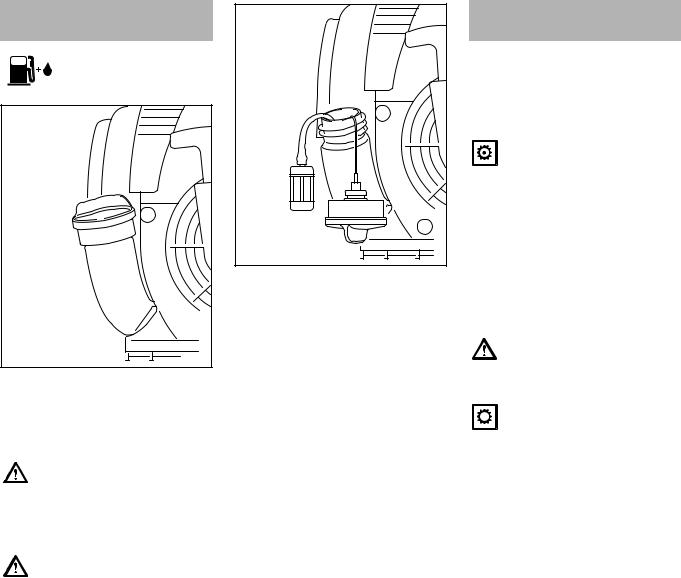
Fueling
 256BA060 KN
256BA060 KN
Before fueling, clean the filler cap and the area around it to ensure that no dirt falls into the tank.
Always thoroughly shake the mixture in the can before fueling your machine.
In order to reduce the risk of burns or other personal injury from
escaping gas vapor and fumes, remove the fuel filler cap carefully so as to allow any pressure buildup in the tank to release slowly.
After fueling, tighten down the filler cap by hand as securely as possible.
250BA051 KN
Change the fuel pickup body every year.
Before storing your machine for a long period, drain and clean the fuel tank. Run the engine until the carburetor is dry.
English
Chain Lubricant
For automatic and reliable lubrication of the chain and guide bar – use only an environmentally compatible quality chain and bar lubricant. Rapidly biodegradable STIHL Bioplus is recommended.
Biological chain oil must be
resistant to aging (e.g. STIHL Bioplus) since it will otherwise quickly turn to resin. This results in hard deposits that are difficult to remove, especially in the area of the chain drive and chain. It may even cause the oil pump to seize.
The service life of the chain and guide bar depends on the quality of the lubricant. It is therefore essential to use only a specially formulated chain lubricant.
Do not use waste oil. Renewed contact with waste oil can cause skin cancer. Moreover, waste oil is
environmentally harmful.
Waste oil does not have the  necessary lubricating properties and is unsuitable for chain lubrication.
necessary lubricating properties and is unsuitable for chain lubrication.
HT 250 |
19 |
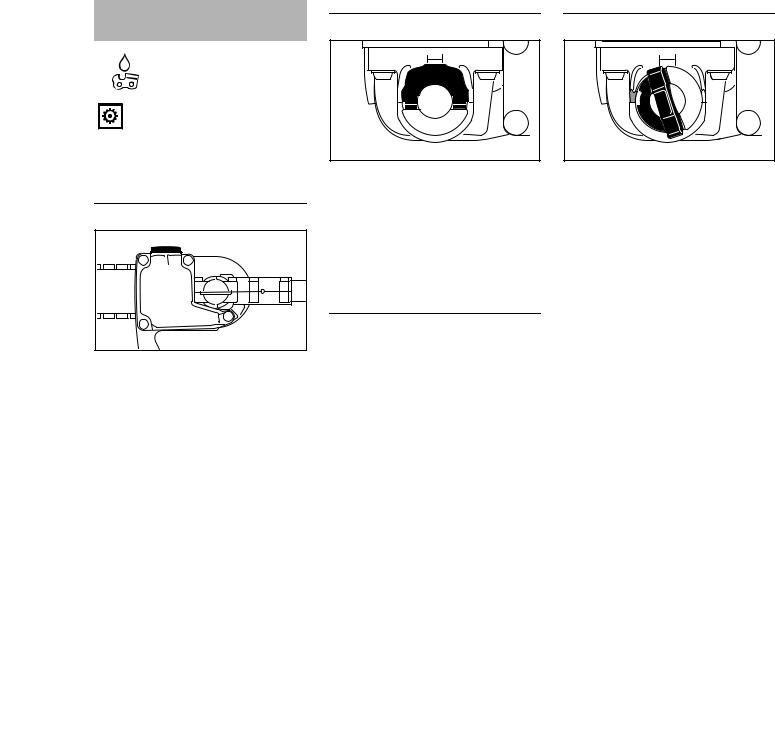
English
Filling Chain Oil Tank
A full chain oil tank is sufficient for only half a tankful of fuel. Check
the oil level regularly during cutting work. Never allow the oil tank to run dry.
Preparations
390BA047 KN |
NThoroughly clean the oil filler cap and the area around it to ensure that no dirt falls into the tank.
NPosition the machine so that the filler cap is facing up.
Opening the filler cap
402BA036 KN |
The bayonet-type oil tank filler cap with hinged grip can be opened and closed without tools.
NTo open the tank, swing the grip to the vertical position.
NTurn the filler cap counterclockwise as far as stop and remove.
Filling up with chain oil
N Filling up with chain oil
Take care not to spill chain oil while refilling and do not overfill the tank.
Closing the filler cap
402BA037 KN
NTo close the oil tank, place the filler cap in position with the grip upright, making sure the recesses are in alignment.
NTurn the filler cap clockwise as far as stop.
NFold the grip down so that it is flush with the top of the cap.
If the oil level in the tank does not go down, the reason may be a fault in the oil supply system: Check chain lubrication, clean the oilways, contact your dealer for assistance if necessary STIHL recommends that you have servicing and repair work carried out exclusively by an authorized STIHL servicing dealer.
20 |
HT 250 |
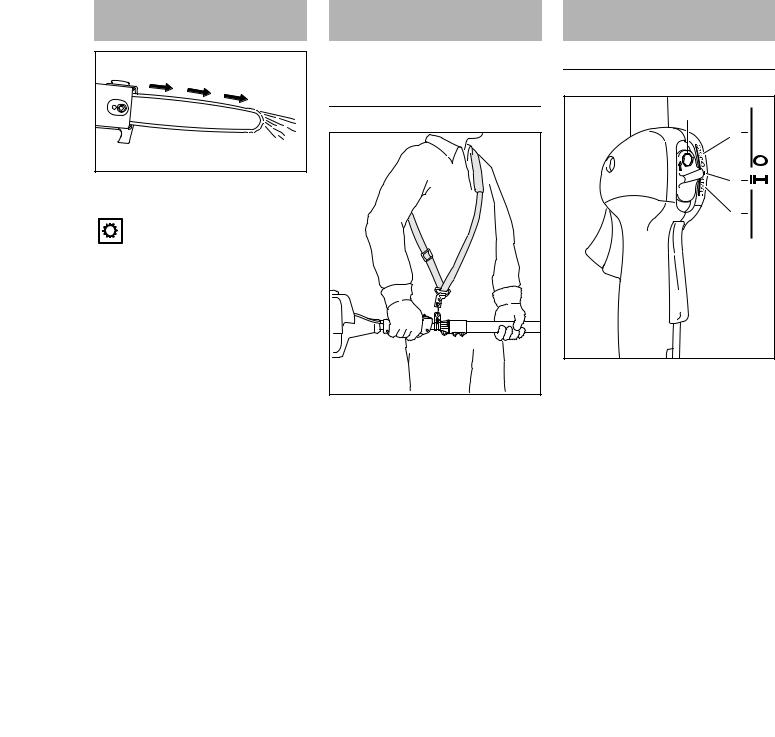
Checking Chain
Lubrication


 390BA048 KN
390BA048 KN
The saw chain must always throw off a small amount of oil.
Never operate your saw without  chain lubrication. If the chain runs
chain lubrication. If the chain runs
dry, the whole cutting attachment will be irretrievably damaged within a very short time. Always check chain lubrication and the oil level in the tank before starting work.
Every new chain has to be broken in for about 2 to 3 minutes.
After breaking in the chain, check chain tension and adjust if necessary – see "Checking Chain Tension".
Fitting the Harness
The type and style of the harness depend on the market.
Shoulder strap
1 |
2 |
390BA040 KN |
N Put on the shoulder strap (1). N Adjust the length of the strap.
NWith the power tool attached, the carabiner (2) must be at about the same height as your right hip.
English
Starting / Stopping the
Engine
Controls
7 |
|
-STOP |
|
4 |
|
|
|
|
STOP |
|
|
3 |
5 |
START |
|
||
|
6 |
|
|
|
2
1
002BA181 KN
1Throttle trigger lockout
2Throttle lever
3Slide control
Positions of slide control
4STOP-0 – engine off – the ignition is switched off
5F– normal run position – the engine is running or can start
6START – the ignition is switched on
– the engine can start
HT 250 |
21 |

English
Symbol on slide control
7h– stop symbol and arrow. To stop the engine, push the slide control in the direction of the arrow on the stop symbol (h) to STOP-0.
Starting
NPress down the throttle trigger lockout lever and squeeze the throttle trigger.
N and hold them in that position.
NMove the slide control to START and hold it there.
NNow release the throttle trigger, slide control and throttle trigger lockout in that order. This is the starting throttle position.
9
|
|
|
|
KN |
|
8 |
250BA018 |
||
|
|
|||
|
|
|
|
|
N Set the choke knob (8):
g If the engine is cold
efor warm start – also use this position if the engine has been running but is still cold.
NPress the fuel pump bulb (9) at least five times – even if the bulb is already filled with fuel.
Starting
N Remove the chain guard.
22
275BA007 KN
NPlace the unit on the ground: It must rest securely on the engine support and the hook. If necessary, rest the hook on a raised support (e.g. a branch, mound or something similar). Check that the chain is not touching any object or the ground.
Check that nobody is standing within the working range of the pruner.
NMake sure you have a safe and secure footing.
NHold the unit with your left hand on the fan housing and press it down firmly – your thumb should be under the fan housing.
Do not stand or kneel on the drive  tube.
tube.
Alternative method:
NRemove the chain guard. Position the shaft on a branch so that it is held by the hook – check that the chain is not touching any object or the ground.
NHold the unit firmly with your left hand on the fan housing – your thumb should be under the fan housing.
NHold the starter grip with your right hand.
NPull the starter grip slowly until you feel it engage and then give it a brisk strong pull.
Do not pull out the starter rope all the way – it might otherwise
break.
NDo not let the starter grip snap back. Guide it slowly back into the housing so that the starter rope can rewind properly.
NCrank the engine until it begins to fire. After no more than five attempts, turn the choke knob to e.
When the engine begins to fire:
N Continue cranking.
HT 250
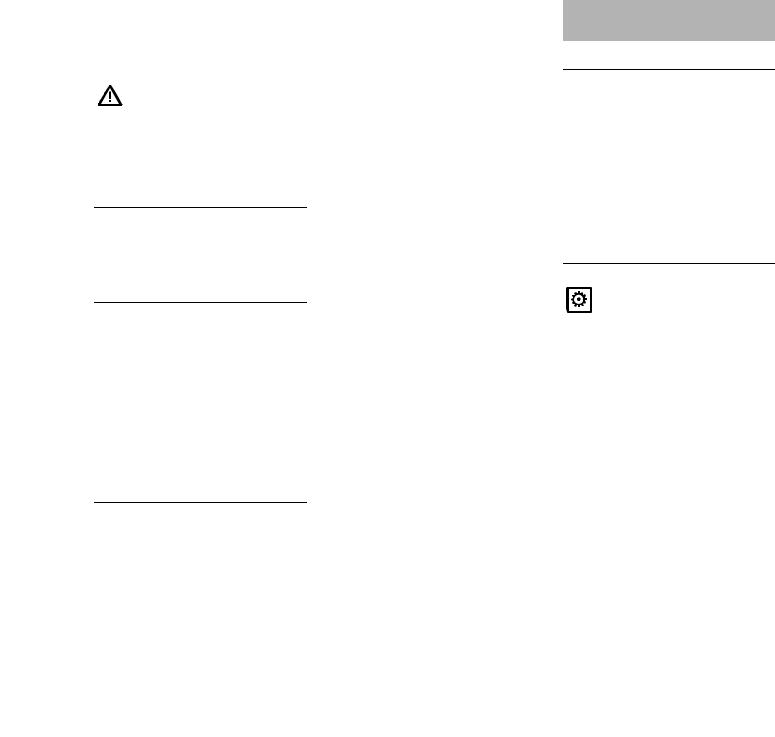
As soon as the engine runs
NBlip the throttle trigger. The slide control moves to the normal run position F– and the engine settles down to idle speed.
Make sure the carburetor is
correctly adjusted. The saw chain must not rotate when the engine is idling.
Your machine is now ready for operation.
Stopping the engine
NPush the slide control in the direction of the arrow on the stop symbol (h) to STOP-0.
At very low outside temperatures:
As soon as the engine runs:
NBlip the throttle trigger to disengage the starting throttle position. The slide control moves to the normal run position F– and the engine settles down to idle speed.
N Open the throttle slightly.
NWarm up the engine for a short period.
If the engine does not start
Choke knob
If you did not turn the choke knob to e quickly enough after the engine began to fire, the combustion chamber is flooded.
N Turn the choke knob to e
NSet the slide control, throttle trigge lockout lever and throttle trigger to the starting throttle position.
NStart the engine by pulling the starter rope briskly – 10 to 20 pulls may be necessary.
If the engine still does not start
N Move the slide control to STOP-0.
NRemove the spark plug – see "Spark Plug".
N Dry the spark plug.
N Open the throttle wide.
NCrank the engine several times with the starter to clear the combustion chamber.
NRefit the spark plug – see "Spark Plug".
N Move the slide control to START.
NSet the choke knob to e– even if the engine is cold.
N Now start the engine.
Throttle cable adjustment
NCheck adjustment of throttle cable – see chapter on "Adjusting the Throttle Cable".
Fuel tank run until completely dry
NAfter refueling, press the fuel pump bulb at least five times – even if the bulb is filled with fuel.
NSet the choke knob according to engine temperature.
N Start the engine.
English
Operating Instructions
During break-in period
A factory-new machine should not be run at high revs (full throttle off load) for the first three tank fillings. This avoids unnecessary high loads during the break-in period. As all moving parts have to bed in during the break-in period, the frictional resistances in the engine are greater during this period. The engine develops its maximum power after about 5 to 15 tank fillings.
During Operation
Do not make the mixture leaner to achieve an apparent increase in
power – this could damage the engine – see "Adjusting the Carburetor".
Check chain tension frequently
A new chain has to be retensioned more often than one that has been in use for some time.
Chain cold
Tension is correct when the chain fits snugly against the underside of the bar and can still be pulled along the bar by hand. Retension if necessary – see "Tensioning the Saw Chain".
HT 250 |
23 |
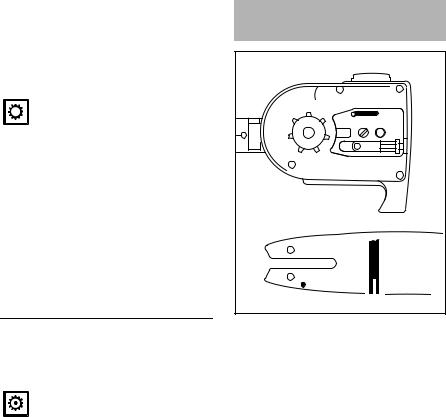
English
Chain at operating temperature
The chain stretches and begins to sag. The drive links must not come out of the bar groove – the chain may otherwise jump off the bar. Retension the chain – see "Tensioning the Saw Chain".
The chain contracts as it cools  down. If it is not slackened off, it
down. If it is not slackened off, it
can damage the gear shaft and bearings.
After long period of full-throttle operation
Allow engine to run for a short while at idle speed so that engine heat can be dissipated by the flow of cooling air. This protects engine-mounted components (ignition, carburetor) from thermal overload.
After Finishing Work
NSlacken off the chain if you have retensioned it at operating temperature during cutting work.
Always slacken off the chain after finishing work. The chain
contracts as it cools down. If it is not slackened off, it can damage the gear shaft and bearings.
Storing your saw for a short period
Wait for the engine to cool down. Drain the fuel tank. Store the machine in a dry location. Check the tightness of all accessible screws and nuts (not adjusting screws) at regular intervals and retighten if necessary.
Storing for a long period
See chapter on "Storing the Machine"
24
Taking Care of the Guide
Bar
|
2 |
|
|
1 |
3 |
KN |
|
390BA050 |
|||
|
|
NTurn the bar over – every time you sharpen the chain and every time you replace the chain – this helps avoid one-sided wear, especially at the nose and underside of the bar.
NRegularly clean the oil inlet hole (1), the oilway (2) and the bar
groove (3).
NMeasure the groove depth – with the scale on the filing gauge (special accessory) – in the area used most for cutting.
Chain type |
Chain pitch |
Minimum |
|
|
groove |
|
|
depth |
Picco |
3/8" P |
0.20" |
|
|
(5.0 mm) |
Rapid |
1/4" |
0.16" |
|
|
(4.0 mm) |
If groove depth is less than specified: N Replace the guide bar.
The drive link tangs will otherwise scrape along the bottom of the groove – the cutters and tie straps will not ride on the bar rails.
HT 250
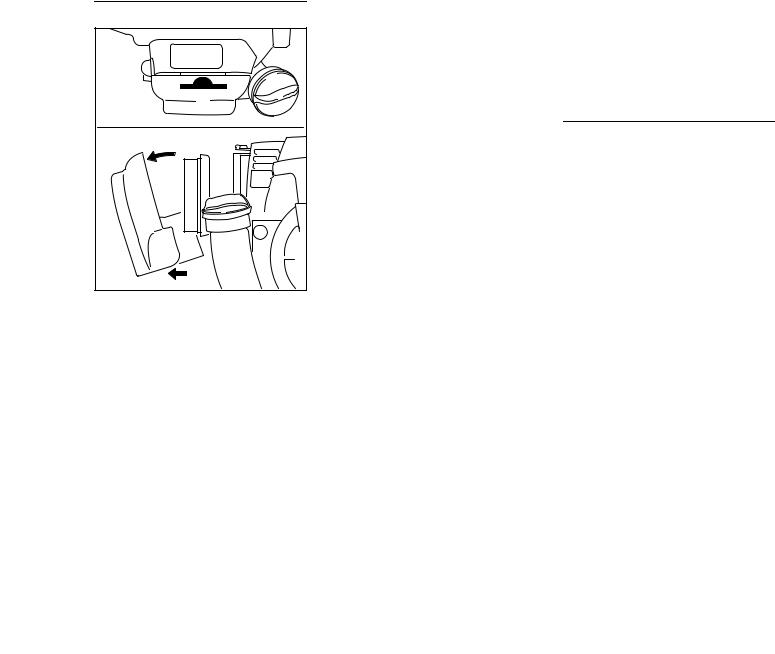
English
|
|
|
|
|
Replacing the Air Filter |
Engine Management |
Adjusting the Carburetor |
||
|
|
|
|
|
If there is a noticeable loss of engine power
1 |
3 |
2 |
250BA022 KN |
N Turn the choke knob to g
NPress in the tab (1) and remove the filter cover (2).
NClean away loose dirt from around the air filter (3) and inside the filter cover.
NRemove the filter element and check it – replace if dirty or damaged.
NInstall the filter element in the filter housing.
N Fit the filter cover.
Exhaust emissions are controlled by the design of the fundamental engine parameters and components (e.g. carburation, ignition, timing and valve or port timing) without the addition of any major hardware.
The carburetor comes from the factory with a standard setting.
This setting provides an optimum fuel-air mixture under most operating conditions.
With this carburetor it is only possible to adjust the high speed screw within fine limits.
Standard Setting
N Stopping the engine
N Check chain tension
NCheck the air filter and replace it if necessary.
NCheck that the throttle cable is properly adjusted – readjust if necessary – see chapter on "Adjusting the Throttle Cable".
NHave the spark arresting screen (not fitted in all markets) checked, and cleaned or replaced if necessary – see “Inspection and Maintenance by Dealer"
HT 250 |
25 |
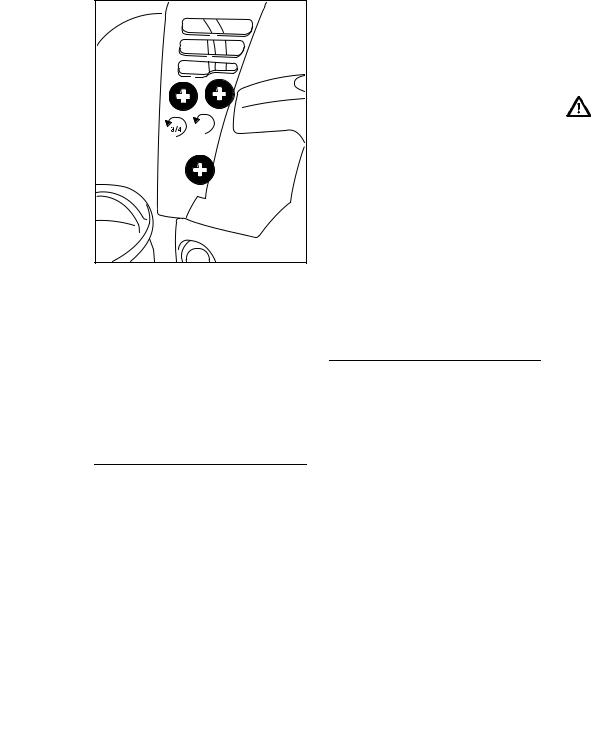
English
H |
L |
|
1 |
||
|
LA
250BA039 KN
NTurn high speed screw (H) counterclockwise as far as stop (no more than 3/4 turn).
NTurn the low speed screw (L) carefully clockwise as far as stop, then turn it back 1 turn.
N Start and warm up the engine.
NAdjust idle speed with the idle speed screw (LA) so that the saw chain does not rotate.
Fine Tuning
A slight correction of the setting of the high speed screw (H) may be necessary if engine power is not satisfactory when operating at high altitude or at sea level.
Rule of thumb:
Turn the high speed screw (H) about one eighth of a turn for every 3300 ft (1000 m) change in altitude.
Conditions for adjustment
N Carry out the standard setting. N Warm up the engine.
N Open the throttle wide.
At high altitude
NTurn the high speed screw (H) clockwise (leaner), no further than stop, until there is no further noticeable increase in engine speed.
At sea level
NTurn the high speed screw (H) counterclockwise (richer), no further than stop, until there is no noticeable increase in engine speed.
It is possible that maximum engine speed may be reached with the standard setting in each case.
Readjust idle
It is usually necessary to change the setting of the idle speed screw (LA) after every correction to the low speed screw (L).
N Warm up the engine.
Engine stops while idling
NTurn the idle speed screw (LA) slowly clockwise until the engine runs smoothly – the saw chain must not rotate.
Chain runs when engine is idling
NTurn the idle speed screw (LA) counterclockwise until the saw chain stops moving and then rotate the screw another 1/2 to 1 turn in the same direction.
If the chain continues moving when the engine is idling, have your power tool checked and repaired by your servicing dealer.
Erratic idling behavior, engine stops even though setting of LA-screw has been corrected, poor acceleration
Idle setting is too lean:
NIdle setting is too lean: Rotate the low speed screw (L) about 1/4 turn counterclockwise until the engine runs and accelerates smoothly.
Erratic idling behavior
Idle setting is too rich
NRotate the low speed screw (L) about 1/4 turn clockwise until the engine runs and accelerates smoothly.
26 |
HT 250 |
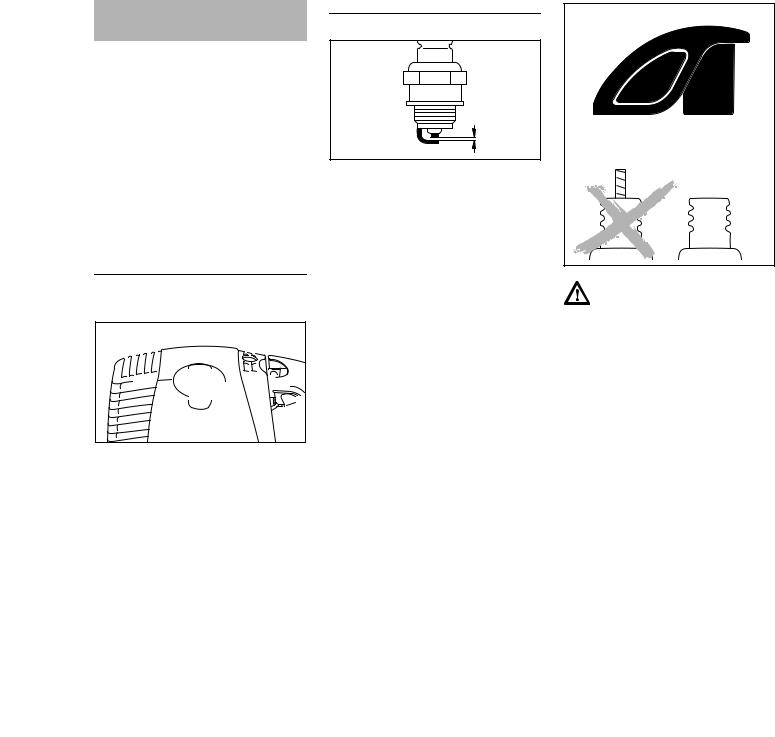
Spark Plug
If engine is down on power, difficult to start or runs poorly at idling speed, first check the spark plug.
Fit a new spark plug after approx. 100 operating hours or earlier if the electrodes are badly eroded.
Wrong fuel mix (too much engine oil in the gasoline), a dirty air filter and unfavorable running conditions (mostly at part throttle etc.) affect the condition of the spark plug. These factors cause deposits to form on the insulator nose which may result in trouble in operation.
Removing the spark plug
N Move the slide control to STOP-0.
 1
1 







 KN249BA063
KN249BA063
N Pull off the spark plug boot (1). N Unscrew the spark plug.
Checking the Spark Plug
|
KN |
A |
000BA039 |
|
N Clean dirty spark plug.
NCheck electrode gap (A) and readjust if necessary – see "Specifications".
NUse only resistor type spark plugs of the approved range.
Rectify problems which have caused fouling of spark plug:
–Too much oil in fuel mix.
–Dirty air filter.
–Unfavorable running conditions, e.g. operating at part load.
English
 2
2
002BA363 KN
Warning!
To reduce the risk of fire and burn injury, use only spark plugs authorized by STIHL. Always press spark plug boot (1) snugly onto spark plug terminal (2) of the proper size. (Note: If terminal has detachable SAE adapter nut, it must be attached.) A loose connection between spark plug boot and ignition wire connector in the boot may create arcing that could ignite combustible fumes and cause a fire.
HT 250 |
27 |
